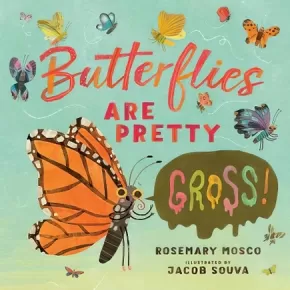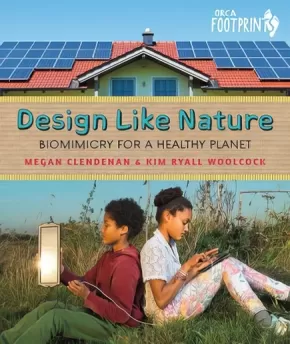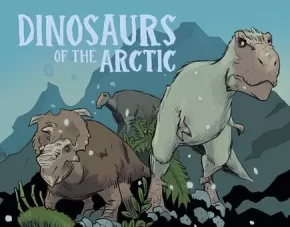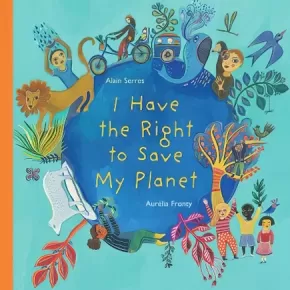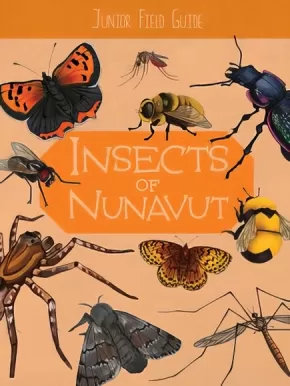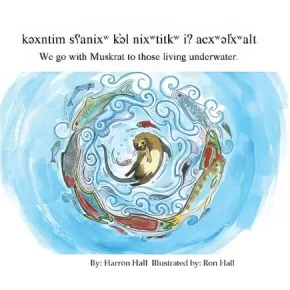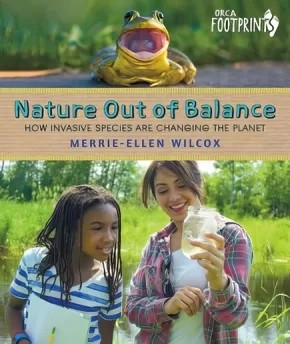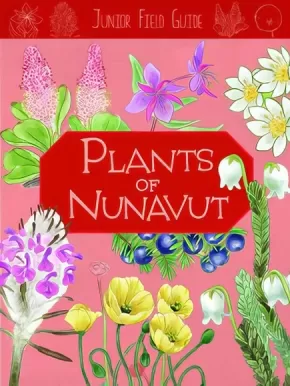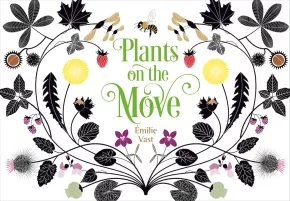
Plants and Animals
106
-
120
of
371 Results;
Sort By
Go To
of 25
Butterflies Are Pretty ... Gross!
$24.99
Artists:
Format:
Hardcover
ISBN / Barcode: 9780735265929
Synopsis:
Synopsis:
Warning -- this book contains top-secret information about butterflies! Prepare to be shocked and grossed out by this hilarious and totally true picture book introduction to a fascinating insect.
Butterflies are beautiful and quiet and gentle and sparkly . . . but that's not the whole truth. Butterflies can be GROSS. And one butterfly, in particular, is here to let everyone know! Talking directly to the reader, a monarch butterfly reveals how its kind is so much more than what we think. Did you know some butterflies enjoy feasting on dead animals, rotten fruit, tears and even poop? Some butterflies are loud, like the Cracker butterfly. Some are stinky -- the smell scares predators away. Butterflies can be sneaky, like the ones who pretend to be ants to get free babysitting.
This hilarious and refreshing book with silly and sweet illustrations explores the science of butterflies and shows that these insects are not the stereotypically cutesy critters we often think they are -- they are fascinating, disgusting, complicated and amazing creatures.
Reviews
“A proboscis-in-cheek introduction to butterflies that will appeal to reluctant readers and bug enthusiasts alike.” --STARRED REVIEW, Kirkus Reviews
Educator & Series Information
Recommended for ages 4 to 8.
This book is part of the Nature's Top Secrets series.
Additional Information
36 pages | 9.38" x 9.44"
Chasing Bats and Tracking Rats: Urban Ecology, Community Science, and How We Share Our Cities
$14.95
Artists:
Format:
Paperback
ISBN / Barcode: 9781773215396
Synopsis:
Synopsis:
Gripping narrative non-fiction with STEM and social justice themes that proves cities can be surprisingly wild places—and why understanding urban nature matters.
What can city bees tell us about climate change? How are we changing coyote behavior? And what the heck is a science bike? Featuring the work of a diverse group of eleven scientists—herself included!—Dr. Cylita Guy shows how studying urban wildlife can help us make cities around the world healthier for all of their inhabitants. In the process, Guy reveals how social injustices like racism can affect not only how scientists study city wildlife, but also where urban critters are likelier to thrive. Sidebars include intriguing animal facts and the often-wacky tools used by urban ecologists, from a ratmobile to a bug vacuum. Cornelia Li’s engaging illustrations bring the scientists’ fieldwork adventures to life, while urban ecology challenges encourage readers to look for signs of wildlife in their own neighborhoods.
Educator Information
Recommended for ages 9 to 12
Themes: biology, environmental science & ecosystems, experiments & projects
Table of Contents
Introduction: Living in the Urban Jungle
Talk Like an Urban Ecologist: Key Terms
Chapter 1: Chasing Down Big Browns
How much do wildlife rely on city green spaces? Cylita Guy tracks bats in Toronto, Canada.
Chapter 2: Ratmobile to the Rescue
How do animals in cities affect human health? Kaylee Byers studies how rats move around Vancouver, Canada.
Chapter 3: Bees and Bug Vacuum
Why are cities a good place to study the impact of climate change on bees? Charlotte de Keyzer looks at what bees and the plants they pollinate can tell us about the effects of climate change in cities like Toronto, Canada.
Chapter 4: Backyard Bear Buffet
What happens when humans and wildlife in cities don’t get along? Jesse Popp gets to the bottom of human-bear conflict in Sudbury, Canada.
Chapter 5: Bold Coyote, Bashful Coyote
How are humans changing animal behavior in cities? Chris Schell studies coyote behavior in Utah and Washington, and looks at how human policies like redlining affect urban biodiversity.
Chapter 6: Microplastics, Major Problems
How does the pollution we create affect city animals? Rachel Giles wades into Toronto’s waterways to discover the impacts of pollution on invertebrates.
Chapter 7: Birdwatching Bias
What happens when citizen science doesn’t tell us the whole story? Deja Perkins asks how human bias can affect what we know about birds in cities like Durham, Chapel Hill, and Raleigh, North Carolina.
Chapter 8: A Bike to Beat the Heat
Why are greener cities better for people? Carly Ziter pedals around Madison, Wisconsin to track how trees cool cities.
Conclusion: But this is only the beginning!
Acknowledgments
Select Sources
Index
Additional Information
104 pages | 7.50" x 9.80" | Paperback
Design Like Nature: Biomimicry for a Healthy Planet
$21.95
Format:
Hardcover
ISBN / Barcode: 9781459824645
Synopsis:
Synopsis:
Did you know that lamps can be powered by glowing bacteria instead of electricity? That gloves designed like gecko feet let people climb straight up glass walls? Or that kids are finding ways to make compostable plastic out of banana peels? Biomimicry, the scientific term for when we learn from and copy nature, is a revolutionary way to look to nature for answers to environmental problems such as climate change.
In Design Like Nature young readers discover innovations and inventions inspired by the environment. Nature runs the entire planet with no waste and no pollution. Can humans learn to do this too? It's time to step outside and start designing like nature.
Educator & Series Information
Recommended for ages 9 to 12.
This book is part of the Orca Footprint series. Kids today inhabit a world full of complex—and often mystifying—environmental issues. Orca Footprints aim to help kids answer their questions about the state of the natural world with well-researched, simply-expressed information and powerful images. With topics such as food production, water, cycling and sustainable energy, these books will inspire kids to take action.
A free, downloadable scavenger hunt activity is available: Scavenger Hunt - Design Like Nature: Biomimicry for a Healthy Planet
Additional Information
48 pages | 8.00" x 9.50"
Dinosaurs of the Arctic - Nunavummi Reading Series
$16.95
Artists:
Format:
Hardcover
ISBN / Barcode: 9781774502655
Synopsis:
Synopsis:
Learn about dinosaurs that lived in the North!
This book gives interesting facts about the different types of dinosaurs and other ancient animals that lived in the Arctic long ago.
Educator & Series Information
This book is part of the Nunavummi Reading Series, a Nunavut-developed series that supports literacy learning while teaching readers about the people, traditions, and environment of the Canadian Arctic. It is a Level 11 book in the series.
Nunavummi Reading Series books have also been officially levelled using the Fountas & Pinnell Text Level Gradient™ Levelling System. This book's F&P Level is M.
Curriculum Connections: History; Science
Recommended for ages 6 - 8.
Additional Information
28 pages | 9.00" x 7.00" | Hardcover
Do You Know Where the Animals Live?: Discovering the Incredible Creatures All Around Us
$24.95
Format:
Hardcover
ISBN / Barcode: 9781771646598
Synopsis:
Synopsis:
From the New York Times-bestselling author of The Hidden Life of Trees comes a book for kids ages 8-12 about animals at home and around the world. Get ready to become an animal expert!
Perfect for STEM home-schooling, online learning, and outdoor education.
Have you ever wondered ….
Are worms afraid of the rain?
Do fish use farts to communicate?
Why do elephants stomp their feet?
Do animals dream? What do they dream about?
Do animals get scared, feel happy, or become excited like we do?
In this highly visual, fun, and interactive book, kids will get to know all sorts of animals, from birds and caterpillars in their own backyard, to grizzly bears in chilly Alaska, to puffer fish in the waters of Australia.
Through a mix of at-home activities, facts, stories, and pictures,kids will learn:
- How to spot animal homes and follow their movements
- How our actions impact animals and their ability to survive and thrive in nature
- About some of the wildest and most interesting creatures on Earth
This wonderful introduction to the animal kingdom features playful questions, fun quizzes, and activities that will help kids study animals in their own backyards—and make the world a better place for them.
Educator Information
Recommended for ages 8 to 12.
Guided Reading Level: R
An introduction to animals and their environments: A thoughtful, informative, and easy-to-understand approach to teaching kids where different animal species live, what they eat, how they interact with their families, how they communicate, and what they think and feel.
Additional Information
84 pages | 8.50" x 11.00" | Hardcover
Forest Magic: A Guidebook for Little Woodland Explorers
$16.95
Artists:
Format:
Hardcover
ISBN / Barcode: 9781771089265
Synopsis:
Synopsis:
A beautifully illustrated, compact, interactive nature guide to exploring the forest for young readers.
What do you notice when you walk in the forest? Different types of trees, plants, and mushrooms? Maybe you hear a squirrel chattering or birds singing. Can you feel all the different kinds of moss? And look there! Hidden animal homes and interesting bugs.
With this compact non-fiction guide, young readers will be equipped to seek out, identify, and appreciate the woodland magic that exists all around them. Featuring rich vocabulary words like "nurse log," "lichen," and "sapling," this beautifully illustrated book is the ideal companion for little forest explorers. Incorporating all five senses and encouraging imaginative play, it even includes pixies and fairies (pixie cup lichen and fairy slipper wildflowers)! Forest Magic will be the book you reach for on the way out the door to explore your own backyard.
There's so much to see in a forest. What will you discover?
Educator & Series Information
Recommended for ages 4 to 8.
This book is part of the Little Explorers Series.
Additional Information
32 pages | 8.00" x 6.50"
Humongous Fungus
$21.99
Artists:
Format:
Hardcover
ISBN / Barcode: 9780744033335
Synopsis:
Synopsis:
Inhabiting a whole kingdom of their own, fungi can be found in every ecosystem.
They carpet the forest floor, and hidden fungi decompose matter, feed plants, and affect how animals function.
Their beautiful mushrooms come in all colors, shapes, and sizes. Fungal stories include the greening of the Earth, when fungi helped plants first grow on land, and the mass destruction of crops through fungal disease. From the villains of the possible extinction of bananas to plastic-eating eco-warriors, there are more than 1.5 million fungus species, and a huge, unknown number of unnamed "dark" types. They affect other creatures, too, for example by helping break down food, or controlling their minds against their will.
Continuing from the gorgeous Under Your Feet, and touching on similar topics of conservation and the secret processes within ecosystems, this book of fabulous fungi will intrigue and amaze young readers.
Educator Information
Recommended for ages 7 to 9.
Additional Information
64 pages | 9.00" x 11.00" | Hardcover
I Have the Right to Save My Planet
$19.95
Artists:
Format:
Hardcover
ISBN / Barcode: 9781773064871
Synopsis:
Synopsis:
This beautifully illustrated picture book is about a child’s right to advocate for the environment they live in.
All children have the right to learn about the world, to celebrate the water, air and sunshine, and to be curious about the animals and plants that live on our planet. All children also have the right to learn about endangered species, to be concerned about plastic in the ocean, and to understand what a changing climate means for our Earth.
Scientists tell us that every living thing is connected. When we cut down forests, we destroy animal habitats. When we throw plastic in the garbage, it never really goes away. When we spray pesticides on our fruit and vegetables, we poison the earth, animals and ourselves.
What can children do to help? All children can draw posters of endangered animals to raise awareness. All children can send a letter to the leader of their country, signed by every member of their family. All children can protest along with their parents. Children have the right to do all these things as proclaimed in the United Nations Convention on the Rights of the Child. All children have the right to try to help our Earth, in whatever ways they can.
Told from the perspective of a child, this colorful and vibrant book explores what it means to be a child who dreams of a beautiful future for their planet.
Educator & Series Information
Recommended for ages 4 to 7.
Part of the I Have the Right series.
Correlates to the Common Core State Standards in English Language Arts:
CCSS.ELA-LITERACY.RI.2.3
Describe the connection between a series of historical events, scientific ideas or concepts, or steps in technical procedures in a text.
CCSS.ELA-LITERACY.RI.3.2
Determine the main idea of a text; recount the key details and explain how they support the main idea.
CCSS.ELA-LITERACY.RI.3.3
Describe the relationship between a series of historical events, scientific ideas or concepts, or steps in technical procedures in a text, using language that pertains to time, sequence, and cause/effect.
CCSS.ELA-LITERACY.RI.2.6
Identify the main purpose of a text, including what the author wants to answer, explain, or describe.
CCSS.ELA-LITERACY.RI.1.8
Identify the reasons an author gives to support points in a text.
CCSS.ELA-LITERACY.RI.2.8
Describe how reasons support specific points the author makes in a text.
Additional Information
48 pages | 10.00" x 10.00"
Insects of Nunavut
$12.95
Artists:
Format:
Paperback
Text Content Territories:
Indigenous Canadian; Inuit;
ISBN / Barcode: 9781774504741
Synopsis:
Synopsis:
There are lot of different types of insects in Nunavut. Learn about what defines an insect, as well as their life cycle, metamorphisis, and adaptions. This science book provides information about what different insects look like, where they live, what they eat, their behaviour, and other interesting facts about them, along with colourful illustrations and photographs.
Educator & Series Information
Recommended for ages 8 to 10.
This book is part of the Junior Field Guide series. Perfect for learning all about living things in the Arctic! These Junior Field Guides give information and interesting facts about the different animals that live in Nunavut. Books in this series also share traditional knowledge about living things and teach the traditional Inuit value of environmental stewardship.
Additional Information
32 pages | 10.00" x 7.50" | Paperback
kəxntim sʕanixʷ k̕əl nixʷtitkʷ acxʷəl̕xʷalt / We Go With Muskrat to Those Living
$15.95
Artists:
Format:
Paperback
Text Content Territories:
Indigenous Canadian; First Nations; Salish; Interior Salish; Syilx (Okanagan);
ISBN / Barcode: 9781926886695
Synopsis:
Synopsis:
Muskrat takes the children through all the many fish that live in the water of the Okanagan valley.
kəxntim sʕanixʷ k̕əl nixʷtitkʷ acxʷəl̕xʷalt / We Go With Muskrat to Those Living Underwater is an interactive story with sʕanixʷ (Muskrat) in the lead, allowing readers to learn both the n’syilxwcn and English names of underwater creatures living in the Okanagan Valley. The book seamlessly combines beautiful imagery with amusing descriptions as Muskrat introduces a diverse set of underwater creatures.
Educator & Series Information
Recommended for ages 6 to 9.
Author Harron Hall has written several children's books that incorporate her Indigenous heritage and her deep commitment to protecting the land and water, including The Water Sings to Suli?, Water Changeling and Lessons from Beaver's Work.
Learn the names of many fish and aquatic creatures that live in the Okanagan Valley in n’syilxwcn (the language spoken by the Sylix/Okanagan peoples) and English.
Features bright and colorful illustrations from Indigenous artist Ron Hall.
This book is part of the Follow the Water series.
Additional Information
40 pages | 8.00" x 8.00"
Mino-te-mah-ti-zee-win, A Good Way of Life Colouring Book
$14.95
Artists:
Format:
Paperback
Text Content Territories:
Indigenous Canadian;
Grade Levels: Kindergarten; 1;
ISBN / Barcode: 9781927849705
Synopsis:
Synopsis:
The National Indigenous Diabetes Association (NIDA) envisions diabetes-free communities. Their mission is to lead the promotion of healthy environments and to prevent and manage diabetes by working together with people, communities, and organizations. NIDA Elders partnered with Kayla Perry, registered dietitian with the Diabetes Integration Project, and the Manitoba First Nations Education Resource Centre (MFNERC) to present this colouring book, which features some traditional plants and animals (Our Relations) from our Elders’ territories and the lands in between.
The purpose of this colouring book is to provide an easy-to-read, visual resource with practical guidance that children and caregivers can use to learn about nutritional information from traditional foods and plants. This resource also shares some teachings and stories attached to these medicines. Traditional foods are plants or animals that are indigenous to the land, meaning they existed naturally on the land before settlers arrived. Food in the form of these plants, fruits, vegetables, or animals is a gift.
NIDA would like to acknowledge that the work for this project took place in the traditional territories of the Dakota, Anishinaabe, Cree, Ojibwe-Cree, and Dene Peoples, and the homeland of the Red River Métis Nation.
Educator Information
Recommended by the publisher for grades 1 and under.
Nature Out of Balance: How Invasive Species Are Changing the Planet
$19.95
Format:
Hardcover
ISBN / Barcode: 9781459823952
Synopsis:
Synopsis:
Plants, animals, insects and fish are moving in. Invasive species threaten local ecosystems and the planet’s biodiversity, but are they all as bad as we think they are? In Nature Out of Balance: How Invasive Species Are Changing the Planet author Merrie-Ellen Wilcox profiles all-star invasive species around the world, starting in her own neighbourhood, and warns that humans are the most invasive species of all. We find out how and why species become invasive, what we can do to stop their spread and whether it’s time to think differently about invasive species that are here to stay.
Reviews
“A well-written volume on a distinctly important topic for youngsters to be aware of as they grow into their role of guardians of the ecosystems. Highly Recommended.” — CM: Canadian Review of Materials
“The balance of hope against the potentially stressful subject leaves readers informed and energized rather than defeated. Handy and lucid, this slim volume makes an important topic digestible.” — Kirkus Reviews
“A high-quality introduction to a topic not often covered in books for middle graders.” — School Library Journal
Educator & Series Information
This book is part of the Orca Footprint series. Kids today inhabit a world full of complex—and often mystifying—environmental issues. Orca Footprints aim to help kids answer their questions about the state of the natural world with well-researched, simply-expressed information and powerful images. With topics such as food production, water, cycling and sustainable energy, these books will inspire kids to take action.
In Nature Out of Balance, we find out how and why species become invasive and practical tips about what we can do to stop their spread.
Globalization means that new invasive species are being found around the world every day, threatening the biodiversity of our neighborhoods, cities, countries and the planet as a whole.
The author has studied ecological restoration and examines invasive species starting in her own backyard.
This book offers a unique perspective on invasive species and how it might be time to rethink how we coexist with them.
Invasive species are often described as the most overlooked environmental threat in the world (in the US they cause $120 billion a year in damage, in BC alone they cost farmers $50 million a year).
Recommended for ages 9 to 12
Additional Information
48 pages | 8.00" x 9.50"
Plants of Nunavut
$12.95
Artists:
Format:
Paperback
Text Content Territories:
Indigenous Canadian; Inuit;
ISBN / Barcode: 9781774502884
Synopsis:
Synopsis:
Learn about the different plants that grow in the Arctic. Despite the cold climate, many plants grow in Nunavut and have important uses. This book provides information about some of these plants, what they look like, how they grow, and how they are used.
Educator & Series Information
Recommended for ages 8 to 10.
This book is part of the Junior Field Guide series. Perfect for learning all about living things in the Arctic! These Junior Field Guides give information and interesting facts about the different animals that live in Nunavut.
Additional Information
32 pages | 10.00" x 7.50" | Colour illustrations and photographs | Paperback
Plants on the Move
$22.99
Artists:
Format:
Hardcover
ISBN / Barcode: 9781623541484
Synopsis:
Synopsis:
Spinning, flying, crawling, exploding! These plants have places to go. A gorgeous, lyrical exploration of how seeds travel from plant to plant, take root, and grow.
When you think of a plant, you don't think of how it moves. But the feathery seeds of the dandelion fly to other gardens, strawberry tendrils creep, and maple seeds spin. There are many different ways plants move, not only as they grow, but in their quest to reproduce: falling, clinging, floating, burrowing--even exploding!
Fourteen plant journeys are chronicled, but more than sixty species are highlighed in Émilie Vast's fantastic and unique art style. Learn the scientific names for the different ways plants move.
Reviews
"Ten ways that plants move are described with detailed silhouette art and a moderate amount of text. The graphic art stands out beautifully within thin black frames against stark white pages. Bold green lettering and an appropriate plant image decorate each single-page chapter heading. The short chapters begin with a plant introducing itself by its common name. Sometimes a plant also addresses readers directly, as with the strawberry: “You know me well, and you love to eat my sweet, red fruit.” However, most of the plants’ supposed narrations move quickly into scientific explanations, including simple definitions of terms such as calyx, pollination, and samara. (Further definitions occur in the backmatter.) There is enough information contained here that the book will benefit from reading over multiple sittings. It excels as a reference book, especially since the graphic art is so clearly detailed that reluctant or beginning readers will be able to learn a great deal from the illustrations alone. The sequence about plant seeds traveling by animal excrement is amazingly graceful, informative, and subtle—in both words and art. Similarly, clear sequences of frames show such things as a winsome fox carrying and dropping a burr and a water lily’s fruit developing and decomposing. Groupings of 24 cultivated plants by place of origin—albeit stated as incomplete—jar with the omissions of Africa, North America, and Oceania. The few examples of human skin are light-complexioned. Leaf and learn." —Kirkus Reviews
"Even young children understand that seeds grow into new plants, but how do seeds reach the soil they need? Accompanied by crisp, stylized artwork set against a contrasting white background, this informational picture book, originally from France, introduces several ways that seeds disperse. The succinct, descriptive text is divided into sections according to the seed movement (e.g., flying, clinging, or being eaten). Each section, in turn, opens with a single or a few representative plants that explain the physical characteristics of themselves and their seeds in a first-person narrative before explaining the benefits of their seed dispersal process. A maple tree, for example, describes the “light, delicate wings” of its seeds that dry up in the fall into “little helicopters,” detach, and spiral down to the ground. A double-page spread at the end of each section offers a beautiful, visual summary of other plants that rely on the same method for their seeds." —Booklist
Educator Information
Recommended for ages 5 to 8
Additional Information
56 pages | 8.56" x 12.41" | Hardcover
The Frog Mother
$23.00
Artists:
Format:
Hardcover
Text Content Territories:
Indigenous Canadian; First Nations; Gitxsan (Gitksan);
ISBN / Barcode: 9781553799016
Synopsis:
Synopsis:
To the Gitxsan of Northwestern British Columbia, Nox Ga’naaw is a storyteller, speaking truths of the universe. After Nox Ga’naaw, the frog mother, releases her eggs among the aquatic plants of a pond, the tiny tadpoles are left to fend for themselves. As they hatch, grow legs, and transform into their adult selves, they must avoid the mouths of hungry predators. Will the young frogs survive to spawn their own eggs, continuing a cycle 200 million years in the making?
Book four of the Mothers of Xsan series follows the life cycle of the Columbia Spotted Frog. Learn about why this species is of special significance to the Gitxsan and how Nox Ga'naaw and her offspring are essential to the balance that is life.
Reviews
"In his engaging book, Hetxw'ms Gyetxw enhances plain biological facts by putting them in their cultural context; for example, the Frog Mother reflects the Gitxsan Nation’s matrilineal system. Donovan provides wonderfully sinuous illustrations that deftly capture frog movement and utilize color." — Kirkus Reviews
Educator & Series Information
Recommended ages: 9 to 12
This is the fourth book in the Mothers of Xsan series, which uses striking illustration and lyrical language to bring the poetry of the Xsan ecosystem to life. The traditional Gitxsan formline art and language weave together throughout the stories in this series to paint a vivid picture of the Gitxsan people.
Mothers of Xsan is a collection of stories that connects the world to the matrilineal society of the Gitxsan people, located in the Pacific Northwest Interior of British Columbia. Each book in the Mothers of Xsan series showcases the depth and importance of the knowledge that has been gathered and shared through this unique style of storytelling. The stories of life cycles, connection to the land, and language are told from the perspective of the animals from the Gitxsan’s traditional territory.
The series presents scientific knowledge in language and a format that is accessible.
Additional Information
32 pages | 6.50" x 10.00"
Sort By
Go To
of 25

